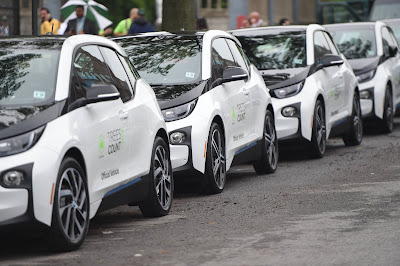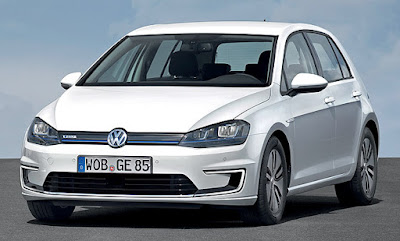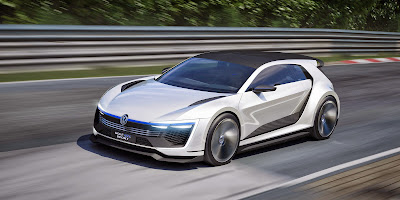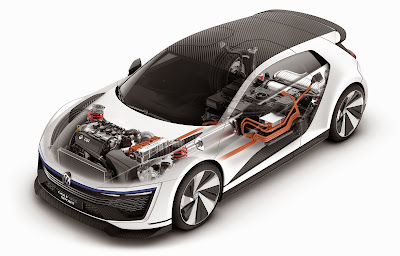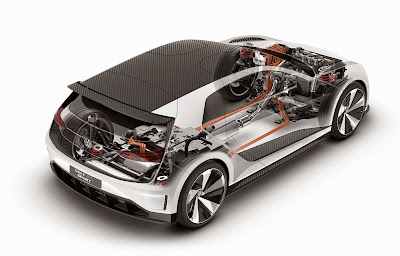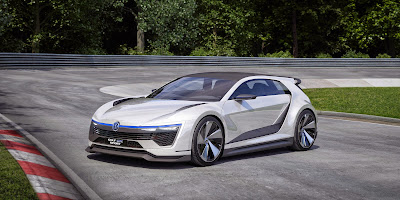VW presented the Golf GTE Sport in a world premiere at the legendary GTI event at Lake Wörthersee on 14 May 2015, Volkswagen is catapulting the GT tradition into the future. The high-tech Golf that is largely made of carbon is powered by a total of three motors – combined in a plug-in hybrid drive with system power of 295 kW / 400 PS. The concept car breaks down traditional barriers between road and motorsport vehicles. Its progressive hybrid system in combination with the high-tech all-wheel drive, a lightweight body, optimum aerodynamic downforce, precision running gear based on the design of the current Golf GTE, a new motor racing cockpit (including visualisation of the racing line) and an unusual seating concept (two monocoque-like interior areas) enable breathtaking performance on the racetrack. At the press of a button, however, the concept car is able to cover a distance of up to 50 kilometres on electric power alone and hence with zero emissions.
Drive system from motorsport and research
World Rally Car TSI engine. The 1.6 litre TSI (turbocharged direct-injection engine) adapted from the superb Polo R WRC (World Rally Car) is accommodated in the engine compartment at the front of the car. It delivers 220 kW / 299 PS and maximum torque of 400 Nm. Volkswagen has already won the World Rally Championship twice with this engine. In the Golf GTE Sport the four-cylinder masterpiece is assisted by two electric motors. The engineers positioned the first electric motor at the front (in the housing of the 6-speed dual-clutch gearbox). It develops 85 kW / 115 PS and maximum torque of 330 Nm. The second electric motor is located at the rear with the same power output but torque of 270 Nm. The total torque of the drive system is 670 Nm. Whenever possible, the concept car is powered solely by electricity without producing any emissions. In sporty "GTE mode" all three motors work together, giving the all-wheel-drive Golf GTE Sport a standstill to 100 km/h time of 4.3 seconds and a top speed of 280 km/h. In the NEDC cycle for plug-in hybrid vehicles the sports car consumes just 2.0 l/100 km/h.
Pure-bred sports car.
Balanced for the Nürburgring north loop. The concept of the Golf GTE Sport has been designed so that the car is at home in both normal road traffic and racetrack conditions. Accordingly, the drive, suspension, body and interior all follow the principle of a pure-bred sports car. The drive system offers maximum agility, the suspension displays maximum neutrality in interaction with the all-wheel drive, the carbon body is lightweight and with its balanced aerodynamics it virtually adheres to the road. The driver ergonomics bridge the gap to motor racing, and with optimum weight distribution and a low centre of gravity the overall package ensures that a lap around racetracks such as the north loop of the Nürburgring is a unique driving experience.
Interior rings in a new sports car era
Two-seater race car. The driver and passenger board the two-seater interior of the Golf GTE Sport through doors that swing right up in the style of the XL 1. The doors extend a long way up into the roof and down into the side sills, resulting in convenient boarding when they are opened upwards. The interior in carbon and microfibre consists of two completely separate areas for the driver and passenger. Like in motorsport vehicles, they sit quite a long way to the back on racing bucket seats with five-point belts. Accordingly, the steering column that is entirely clad in carbon projects a long way into the interior where it appears to float – a further characteristic feature of a rally car or touring-car racer. The functional elements are operated via controllers and buttons in the cocoon-like interior trim. The gearbox of the Golf GTE Sport can also be operated manually with shift paddles on the motorsport steering wheel.
Instruments on three levels. The instruments featuring a completely new design have been specially coordinated for the configuration of the driver's workspace. The Volkswagen interface designers opted for three transparent displays arranged behind one another on which all relevant information is displayed. On the smallest display at the front (closest to the driver) information such as the selected gear and the recuperation status is displayed; information that is only sporadically checked from the corner of the eye whilst driving. The centre display has secondary yet more complex information such as the power currently delivered by the drive (power meter) and the boost intensity of the plug-in system (electric boost). Information such as the current speed and the range are constantly in the driver's field of vision on the third and largest display. In addition, in "GTE mode" not only is the current lap displayed (e.g. 9 of 16), but there is also a virtual indicator of the ideal driving line – valuable assistance for safe and fast driving on complex racetracks such as the aforementioned Nürburgring north loop.
Ergonomic perfection. The clearly arranged multifunction switch for starting and stopping the hybrid drive and controlling the 6-speed DSG is ideally positioned to the right of the driver for easy access. Right next to it there is a control panel for further vehicle functions; these include a button for activating a fire extinguishing system similar to that used in motorsport. Furthermore, the passenger is also supplied with data via a display in his interior segment. In "Info Mode" the current speed, the gear currently engaged and the engine speed can be displayed. If the passenger switches to "Data Mode" he can call up the vehicle acceleration and lateral force figures (g- forces). It is not only the use of carbon, but rather a general lightweight design that saves weight in the interior. For example, the loops for opening the doors are made of the same synthetic fibre as the five-point belts. Moreover, extremely elaborate ergonomics prevail in every detail. The operating mode switch for selecting "E- Mode", "GTE-Mode" or "Hybrid-Mode", for example, is situated in the roof, like in a jet plane.
Body design and concept
Extremely lightweight. The body of the Golf GTE Sport is largely made of lightweight carbon. As both a brand and a group, Volkswagen is a trailblazer in the industrial use of this material. For example, like the exterior of the Bugatti Veyron 16.4, the body of the Volkswagen XL1 is also made of carbon. The high-strength carbon body of the Golf GTE Sport therefore weighs much less than a comparable steel body.
Side profile. The design concept of the Golf GTE Sport manifests itself in the car's striking silhouette. Here, Volkswagen is continuing the idea of C-pillars with a two-level design originating from the 2007 Golf GTI W12-650, which has been constantly further perfected in various concept cars. On the Golf GTE Sport that is now being presented, this C-pillar concept, which is unique worldwide, has reached a degree of perfection that allows it to leave the show car stage and – as a design vision – bridge the gap to the Golf GT models of the future. The basic styling of these pillars (like the string of a bow taut with an arrow) follows the unmistakable Golf design, but at the same time feature some completely new C-pillar details: behind the level visible from outside a second one opens up. The airstream flows between these two levels and is contributing to the aerodynamic downforce and to the cooling of the rear brake system. Stylistically, this concept means that the rear section (like the front section) is extremely wide. By contrast, the passenger cell between the A-pillar and the interior part of the C-pillar becomes narrower when viewed from the front to the rear – an avant-garde interplay of extremely powerful shapes.
Doors and sills fold upwards. As described, the concept car painted in pearlescent "White Club" has two gullwing doors that swing forwards. The upper part that extends a long way into the roof is entirely made of dark visible carbon. A large part of the side sill is integrated in the door cutout. The three-dimensional body of the sill is enhanced at the top in the door section with an area in dark visible carbon. Further features on the side profile in visible carbon are the door mirror caps, the door window frames and the lower sill area. This part of the sill is designed as a splitter, i.e. a thin and sharp aerodynamic element, a feature familiar in motorsport. The side sill is framed by the new 20-inch alloy wheels fitted with tyres in format 235 at the front and 275 at the rear.
Front. With the front section of the Golf GTE Sport the Volkswagen design team is impressively illustrating how the Golf GT models could develop in future. On the concept car, the designers removed the striking blue radiator grille line of the Golf GTE production model from the grille and positioned it below the bonnet as a blue crossbar running across the whole width of the front. Below it, three further crossbars in black chrome look extend across the centre air inlet. The high-gloss black air inlet grille itself has the honeycomb structure typical of GT models. A further air inlet below the crossbars is framed at the top and to the sides by a striking aerodynamic element (also made of carbon). A double spoiler, also designed as a splitter, rounds off the front. Here, too, carbon is used.
LED headlights and daytime running lights. All electric and plug- in hybrid models from Volkswagen have C-shaped LED daytime running lights as a distinctive feature, and the Golf GTE Sport is no exception. Here, they frame the whole radiator grille unit at the sides, and in the top area there is an almost seamless transition from the LED daytime running lights to the extremely narrow and sharp LED headlights.
Rear. Never before has Volkswagen realised such a charismatic and sporty rear for a Golf. Here, too, the two levels of the C-pillars are a defining stylistic feature giving the Golf GTE Sport a very wide and powerful appearance from the rear. The extended outer levels of the C-pillars at the rear – like the tail unit of an aeroplane – elongate the car together with the large roof spoiler. Typically Golf: the striking tailgate with a vertical downward angle at the level of the redesigned LED rear lights. At the top, the tailgate is limited by a black carbon roof spoiler – a wing that seems to hover in front of the tailgate at a distance of a few millimetres to the roof. The C-pillars that taper at an angle to the rear and the bumper merge into one another, with the latter projecting far above the line of the tailgate. As an imaginary continuation of the side strip made of visible carbon (above the sill), the top edge of the bumper also features visible carbon. Below this is an area painted in the body colour (with air outlets on the outside). The last level is a large diffuser made of visible carbon with the splitter that is also continued here. The round stainless steel trims of the twin-pipe exhaust system are integrated in the middle of the diffuser.
Drive – plug-in hybrid and electric propshaft
E-Mode – setting off on electric power. No Golf has ever had three motors before. But this one does. As described at the beginning, the combustion engine fitted by Volkswagen is a turbocharged 1.6-litre four-cylinder direct-injection engine (TSI) that produces 220 kW / 299 PS of power and a maximum torque of 400 Nm. The electric components consist of the lithium-ion battery and two electric motors. The front electric motor is integrated in the housing of the 6- speed DSG (DQ400E). Both electric motors have a power output of 85 kW. The total available system power is 295 kW / 400 PS. If necessary, the system drive power can be distributed to all four wheels thanks to the rear electric motor and an "electric propshaft". In normal operation the Golf GTE Sport drives just as quietly as the production Golf GTE that is already marketed. In "E-Mode" it is setting off purely electrically. In this case the concept car uses the battery that can be charged externally (but also whilst driving) to cruise without producing any emissions. It can cover up to 50 kilometres on a battery charge. When a defined minimum battery charge is reached, the 1.6 TSI is automatically switched on and the Golf GTE Sport drives in "Hybrid" mode. As soon as the battery reaches a certain charge level again, "E-Mode" can be reactivated at any time via a switch in the overhead console. In "E-Mode", the rear axle electric motor is first and foremost responsible for propulsion. When high demands are made on performance, the front electric motor is also activated to provide support.
Hybrid mode – silent coasting. As soon as the drive system or the driver deactivates "E-Mode", the Golf GTE Sport becomes a classic full hybrid with regenerative braking charging the battery and automatic utilisation of the right combination of TSI and/or electric motors according to the specific drive situation. When the driver releases the accelerator pedal, and the battery is sufficiently charged, all drive sources are shut off. This is referred to as "coasting". If the driver releases the accelerator pedal or brakes, and the battery is insufficiently charged, the two electric motors operate as generators and charge the lithium-ion battery with the energy recovered from braking. With the dual mode "Battery Hold" or "Battery Charge" the battery's energy content can be deliberately kept constant by the driver ("Hold") or increased ("Charge"). When the 1.6 TSI engine is the sole source of propulsion, the concept car is a pure front-wheel drive car.
GTE-Mode – the power of three hearts. The switch on board the Golf GTE Sport that is most important for dynamic performance is located in the overhead console. It bears the letters "GTE". When the driver operates this switch, the character of the Golf GTE Sport's drivetrain changes drastically in an instant because now the full system power of 400 PS is available. The turbocharged 299 PS petrol engine alone delivers immense propulsive power, and at this high level the electric drive components of the Golf GTE Sport assume an additional boost function. The boost effect is so strong that the drive unit would also perform well if used in professional touring car races: the Golf GTE Sport sprints to 50 km/h in 1.8 seconds, reaches 100 km/h in 4.3 seconds, and the maximum speed permitted in Austria, i.e. 130 km/h, in 6.5 seconds. On German motorways, the concept car reaches 200 km/h in 15.9 seconds. In "GTE-Mode" all four wheels of the Golf are driven.
All-wheel drive – "electric propshaft". In "GTE-Mode" and as soon as the situation necessitates it, the drive power of the Golf GTE Sport is distributed to both axles. In this case (and if battery charge is low), the front electric motor – which is now being supplied with kinetic energy via the TSI – acts solely as a generator and a source of electricity for its counterpart at the rear axle. Since the energy for driving the rear axle flows by wire and not mechanically here, this is referred to as an "electric propshaft". Because the TSI drives the rear electric motor via the front electric motor, the all-wheel drive system also operates when the battery's charge state is low – an invaluable advantage in terms of driving dynamics. The importance of the implementation of the "electric propshaft" for Volkswagen with regard to series production is demonstrated by the fact that the company has had the German equivalent of this designation protected under copyright law.

 A preliminary settlement for Volkswagen and Audi TDI diesel cars with 2.0-liter 4-cylinder engines is awaiting approval by a federal judge. But the Volkswagen Group and U.S. regulators have not made as much progress in addressing affected VW, Audi, and Porsche TDI models with 3.0-liter V-6 diesel engines. Audi's sales boss now believes an...
A preliminary settlement for Volkswagen and Audi TDI diesel cars with 2.0-liter 4-cylinder engines is awaiting approval by a federal judge. But the Volkswagen Group and U.S. regulators have not made as much progress in addressing affected VW, Audi, and Porsche TDI models with 3.0-liter V-6 diesel engines. Audi's sales boss now believes an...  A preliminary settlement for Volkswagen and Audi TDI diesel cars with 2.0-liter 4-cylinder engines is awaiting approval by a federal judge. But the Volkswagen Group and U.S. regulators have not made as much progress in addressing affected VW, Audi, and Porsche TDI models with 3.0-liter V-6 diesel engines. Audi's sales boss now believes an...
A preliminary settlement for Volkswagen and Audi TDI diesel cars with 2.0-liter 4-cylinder engines is awaiting approval by a federal judge. But the Volkswagen Group and U.S. regulators have not made as much progress in addressing affected VW, Audi, and Porsche TDI models with 3.0-liter V-6 diesel engines. Audi's sales boss now believes an...  If all goes according to plan, more than 450,000 owners of Volkswagen and Audi sedans, wagons, and hatchbacks with 2.0-liter TDI diesel vehicles from the 2009 through 2015 model years will start to receive buyback offers from VW late this year. Many owners have already indicated that they plan to take the buyout, some as soon as possible. But it...
If all goes according to plan, more than 450,000 owners of Volkswagen and Audi sedans, wagons, and hatchbacks with 2.0-liter TDI diesel vehicles from the 2009 through 2015 model years will start to receive buyback offers from VW late this year. Many owners have already indicated that they plan to take the buyout, some as soon as possible. But it... 


